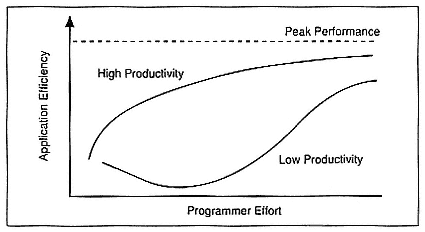Programmer Productivity on Massively Parallel Systems
High performance and attractive price/performance are not enough to bring massively parallel systems into the computing mainstream. It is well known that only 10–20 per cent of computer center's budget goes to paying for computer hardware. The largest portion goes to paying for people to write software and to support the computers. Large gains in price/performance can be quickly erased if the system is difficult to use. In order to be accepted by a larger number of customers, massively parallel systems must provide ease-of-use and programmer productivity that is more like current mainstream high-performance systems.
The conventional wisdom in the 1980s was that parallel systems are difficult to use because it is hard to parallelize code. However, many problems are naturally parallel and readily map to parallel architectures. For these problems, the past has been spent trying to develop serial algorithms that solve these problems on single-CPU systems. Trying to take this serial code and parallelize it is clearly not the most productive approach. A more productive way is to directly map the parallel problem onto a parallel system.
Also, most computer systems today are parallel systems. Minicomputers, workstations, minisupers, supercomputers, even mainframes all have more than a single CPU. Clearly, parallelism itself isn't the only problem, since such systems from major computer vendors are now considered mainstream computers.
Yet there is a programmer productivity gap on most massively parallel systems, as illustrated in Figure 4. While the productivity on

Figure 4.
The programmer-productivity gap.
small-scale parallel systems now mirrors the traditionally higher productivity of uniprocessor systems, the productivity on these massively parallel systems is still very low. Given that there are plenty of parallel problems and that parallel processing has reached the mainstream, what is still holding massively parallel systems back? The answer lies in their software development environment.